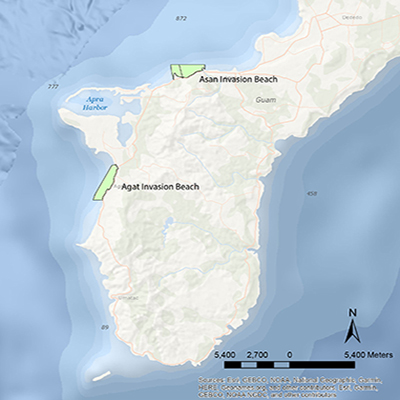Guam: A Biogeographic and Maritime Cultural Landscape Exploration of a World War II Amphibious Battlefield
Expedition Overview
Expedition Overview
Part 1: January 27-February 25, 2023
From January 27-February 25, 2023, a team of researchers will begin their search for submerged shipwrecks, aircraft, amphibious vehicles, artillery and other artifacts related to the 1944 invasion of Guam during World War II (WWII).

Download largest version (jpg, 1.2 MB).
This expedition is the first of two that aims to further our understanding of one of the most significant invasions of the WWII Pacific theater as well as how it may have shaped the natural environment in the area today.
During WWII, Guam was a strategic military location for both the United States and Japan. In July 1944, U.S. troops invaded and secured the Japanese-held island. There has never been a comprehensive underwater inventory of the battle-related items that may still exist. Evidence suggests there is a significant amount of what are now viewed as cultural resources on the seafloor near the landing beaches of Asan and Agat. Both areas are now part of War in the Pacific National Historical Park.
This winter, the team will conduct underwater remote sensing and diver-based photogrammetry surveys to map the seafloor and portions of the barrier reef near these landing beaches. They will use these data to identify the location of battle-related cultural resources and characterize the seafloor environment. Technicians will also conduct elevation surveys of the beaches to investigate how war-related impacts to the reef may be affecting coastal vulnerability to natural hazards like storms and sea-level rise.
With the winter expedition data and questions in hand, the project team will return to Guam this summer to conduct detailed exploration of areas and targets of interest using divers and a remotely operated underwater vehicle.

Download largest version (jpg, 2.1 MB).

Download largest version (jpg, 1.8 MB).
Part 2: July 27-August 23, 2023
From July 27 to August 23, 2023, a team of researchers will return to the Asan and Agat units of War in the Pacific National Historical Park on the western coast of Guam for the second part of this two-part project.
During this visit, divers will investigate each of the targets identified in the deep water outside the barrier reef during the earlier fieldwork and document cultural resources on the seafloor (e.g., shipwrecks, aircraft, amphibious vehicles, and artillery) that may be related to the 1944 invasion of Guam. Select significant resources will be documented with photogrammetry. In addition, team members will walk and snorkel the shallow waters inside the barrier reef to search for and document potential cultural resources. The team will also continue their studies of how World War II-related activities have altered Guam’s coral reef ecosystem and coastal processes, especially in light of May 2023’s Typhoon Mawar.
